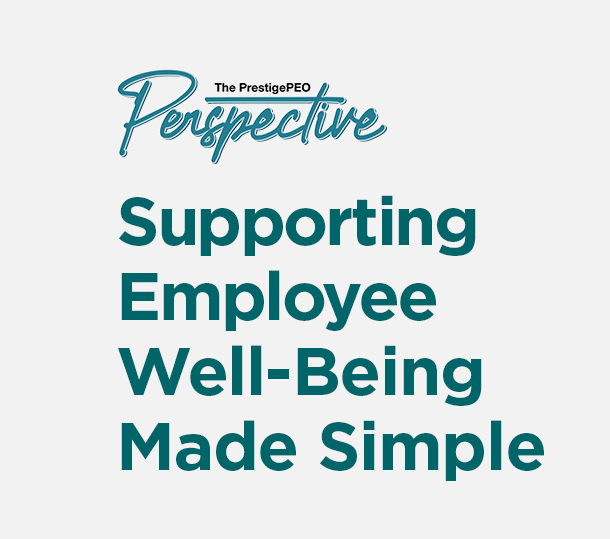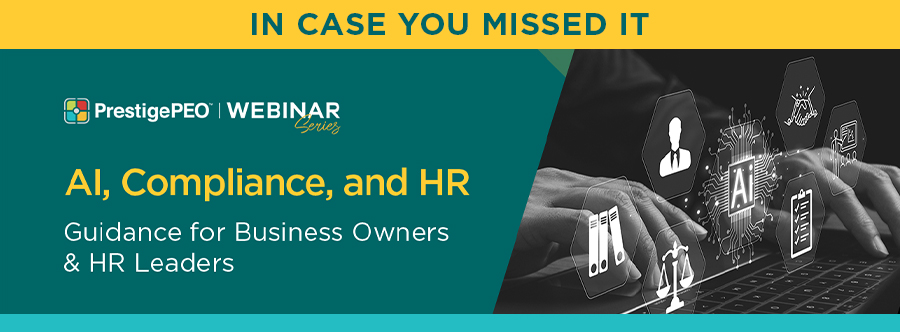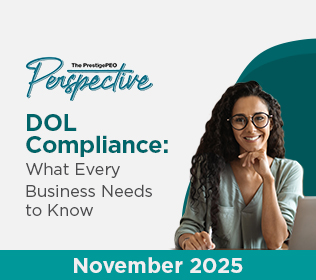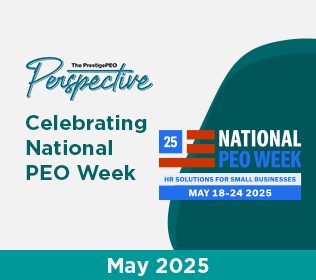

Because Supporting Your Employees Shouldn’t be Complicated
When personal stressors seep into the workplace, productivity, engagement, and retention all suffer. Employee Assistance Programs (EAPs) are a powerful yet often underused tool for supporting your workforce.
In our latest blog, learn how PrestigePEO simplifies EAP implementation, increases utilization, and helps SMBs punch above their weight in benefits, all with minimal administrative burden.

Take the Guesswork Out of Unemployment Claims
7 FAQs Every Employer Should Know About Unemployment Claims
Navigating unemployment claims can be time-consuming and confusing, especially when every state’s process is different.
Our newest FAQ breaks down the seven most common employer questions, from eligibility and documentation to contesting claims. See how PrestigePEO helps reduce risk, ensure compliance, and handle claims efficiently so you can stay focused on your business.

How AI Can Drive Smarter HR and Business Decisions
Artificial Intelligence is transforming HR, benefits, and business operations, but how can small and medium-sized employers harness it responsibly?
If you missed our recent webinar, catch the full recording to hear from PrestigePEO experts on practical AI applications, compliance considerations, and strategies to drive efficiency across your organization.

Your Guide to 2026 Paid Leave Law Updates Across the U.S.
The Clock Is Ticking to January 1: Your Guide to Major State Paid Leave Rules
As we have been reporting, starting in mid-2025 and running through 2026, many states are rolling out or expanding paid family, medical, and sick-leave laws. These changes affect payroll deductions, leave accruals, eligibility, job protection, and health-benefit continuation. Below is summary of what is changing in each state, complete with effective dates and key employer responsibilities, to help ensure compliance with necessary policy and system updates as well as timely notice requirements.
Alaska — Paid Sick Time: Alaska’s statewide paid sick time began July 1, 2025, and will continue to phase in additional requirements during 2026. Employees earn one hour for every thirty hours worked. Employers with fifteen or more employees must allow up to fifty-six hours per year, while smaller employers may cap at forty. Unused hours carry over, so set up payroll accrual tracking and provide the required notices.
Colorado — Paid Family and Medical Leave (NICU expansion):
Effective January 1, 2026, Colorado’s Paid Family and Medical Leave (FAMLI) program will expand to provide an additional 12 weeks of paid leave to a parent whose newborn requires care in a Neonatal Intensive Care Unit (NICU). This is in addition to the standard 12 weeks already available, allowing up to 24 total weeks of paid, job-protected leave in the same benefit year. Job protection and wage replacement will continue under existing Colorado FAMLI rules, which provide partial wage replacement funded through state-administered contributions. Employers offering short-term disability (STD) or paid parental leave should ensure benefits coordinate with FAMLI so total payments do not exceed 100% of wages. Employers should also update return-to-work and benefit coordination procedures to reflect the longer entitlement period.
Connecticut — Paid Sick Time and Family/Medical Leave:
Effective October 1, 2025, non-certified school staff will gain job-protected family and medical leave under Connecticut law. Beginning January 1, 2026, employers with eleven or more employees must provide up to forty hours of paid sick time per year, accruing at a rate of one hour for every thirty hours worked. Employers are strongly encouraged to prepare in advance of these changes by reviewing and updating relevant policies and systems. Specifically, employers should implement or enhance accrual tracking processes—for example, by using timekeeping systems such as Kronos—to accurately monitor leave accrual and usage. In addition, employers should work with their HR Business Partners (HRBPs) to update employee handbooks and leave policies to reflect the new requirements and ensure compliance. Finally, be sure to post all required state notices as issued by the Connecticut Department of Labor.
Delaware — Paid Family and Medical Leave: Payroll contributions began on January 1, 2025, and employees may begin filing claims on January 1, 2026. Employers with ten or more employees in Delaware must participate in the state’s Paid Family and Medical Leave (PFML) program. Employers with twenty-five or more employees are required to provide the full range of benefits, including parental leave, family caregiving leave, medical leave for the employee’s own serious health condition, and military family leave.
Eligible employees may receive up to twelve weeks of paid parental leave or six weeks of leave to care for their own or a family member’s serious health condition, with wage replacement of up to eighty percent of the employee’s average weekly wage, capped at $900 per week. Amendments effective July 30, 2025, prohibit employers from requiring employees to use other paid time off before accessing PFML benefits and streamline private-plan administration for employers that choose to offer an approved equivalent plan.
District of Columbia — Short-Term Disability and Paid Leave Coordination: Effective May 1, 2025, short-term disability benefits may not be reduced because an employee also receives the city’s paid leave. Update plan documents and payroll to avoid offsets.
Hawaii — Paid Family and Medical Leave: Hawaii’s statewide paid family and medical leave program is expected to begin in 2026, though the state has not yet finalized the exact effective date. The program will provide up to twelve weeks of paid family leave and up to twenty-six weeks of paid medical leave for an employee’s own serious health condition, funded through payroll contributions. Employers will need to coordinate benefits with Hawaii’s existing Temporary Disability Insurance (TDI) program to avoid overlapping wage replacement. Employers are encouraged to monitor updates from the Hawaii Department of Labor and Industrial Relations (DLIR), update handbooks, leave policies, and payroll systems to ensure compliance, and post required employee notices once official guidance is released.
Illinois — Military Funeral Honors, Lactation, Donation, and Leave: On August 1, 2025, covered employers must provide up to eight paid hours per month (capped at forty per year) for military funeral honors. On January 1, 2026, paid lactation breaks and expanded blood and organ donation leave take effect. On June 1, 2026, the Neonatal Intensive Care Leave Act grants ten unpaid days (employers with sixteen to fifty employees) or twenty unpaid days (fifty-one or more). Neonatal leave is separate from federal family and medical leave and cannot require using accrued paid time off first.
Indiana — School Conference Leave: In 2026, employers must allow unpaid time for parents to attend a child’s school conferences or meetings, with at least five days’ notice and reasonable documentation. A request may be denied if already used once that year or if the time requested exceeds what is needed.
Iowa — Paid Family and Medical Leave: Payroll deductions began January 1, 2025, and benefits start January 1, 2026. Covered reasons include bonding with a new child, caring for a family member, or addressing an employee’s own serious health condition. The program provides wage replacement funded through payroll contributions. Employers are encouraged to review and upload contribution tables, align internal leave policies, and establish a simple process to coordinate company leave programs with state benefits to ensure smooth administration and compliance.
Kansas — Paid Sick Time: Effective January 1, 2026, employees will accrue one hour of paid sick time for every thirty hours worked. Employers may set a reasonable annual cap on accrual or use, and under the state’s guidance, many are expected to limit annual use to up to eighty hours, which is permitted as long as the policy is clearly communicated and applied consistently. Employers may request medical documentation after three consecutive missed workdays. To prepare, employers should implement an accrual tracking system, update policies, and post the required state notice once it becomes available.
Kentucky — Paid Sick and Safe Leave: Beginning January 1, 2026, employers with eleven or more employees must provide paid sick and safe leave; the requirement expands to all employers on January 1, 2027. Accrual (not accuracy) occurs at a rate of at least one hour for every thirty hours worked, and employers may cap annual use at forty hours. Leave may be used for an employee’s own illness, to care for a family member, or for safety-related needs connected to domestic violence, sexual assault, or stalking. Employers must maintain confidentiality regarding any information shared and establish clear non-retaliation procedures to protect employees who use this leave.
Louisiana — Paid Family and Medical Leave: Payroll deductions began January 1, 2025, and benefits will start on May 1, 2026. Employees may receive up to twelve weeks of paid leave to bond with a new child, caring for a family member, or addressing their own serious health condition. Employers should verify payroll deductions for accuracy, update internal leave procedures, and post required state notices once issued. In addition, employers should create a clear claims support checklist and train HR staff to help employees navigate the application process and coordinate company leave benefits with the state program.
Maine — Paid Family and Medical Leave: Contributions began January 1, 2025, and benefits start May 1, 2026. Employees may take up to twelve weeks per year for their own health, family care, bonding, certain military needs, and safe leave. Eligibility generally requires one hundred twenty days of employment and earnings of at least six times the state average weekly wage; employers with fifteen or more employees pay a higher share, and comparable private plans may qualify.
Maryland — Paid Family and Medical Leave: Benefits begin July 1, 2026, with weekly payments ranging from fifty to one thousand dollars through 2028. An “anchor date” will set the application year and wage calculation. Prepare for mid-year deductions, new notices, and claims handling that follows the anchor-date rules.
Massachusetts — Paid Family and Medical Leave Benefit Cap: On January 1, 2026, the maximum weekly benefit rises to $1,230.39 while the contribution rate remains the same as 2025. Employers with private plans must confirm their benefits still meet or exceed the higher cap and continue allowing employees to top off with accrued paid time off.
Minnesota — Paid Family and Medical Leave: Benefits under Minnesota’s Paid Family and Medical Leave program begin January 1, 2026. Employers must post the state notice and distribute written information to employees by December 1, 2025, begin payroll deductions on January 1, 2026, and submit the first premium payment by April 30, 2026. Employees may take up to 12 weeks of medical leave and 12 weeks of family leave, with a maximum of 20 weeks combined per benefit year. Most workers will receive approximately 55%–90% of their average weekly wage, up to the state’s average weekly wage cap. Coverage includes full-time, part-time, and temporary employees, and independent contractors may opt in voluntarily.
Nebraska — Paid Sick Time: Effective October 1, 2025, Nebraska’s Paid Sick Time law requires employers with 11–19 employees to provide up to 40 hours of paid sick time per year, and employers with 20 or more employees to provide up to 56 hours per year. Employees will accrue one hour of paid sick time for every 30 hours worked after completing 80 consecutive hours of work in Nebraska. The model notice refers to a state-issued document that outlines employees’ rights and employer obligations under the Paid Sick Time law. It will include key details such as how sick time accrues, eligible uses, carryover rules, and protection from retaliation. Employers are required to provide this notice to all employees, post it in a visible workplace location, and include paid sick time balances and year-to-date usage on each employee’s pay stub or statement to ensure compliance and transparency.
New York City — Earned Safe and Sick Time (City Amendments): Council approved Sept 25, 2025; effective 120 days after the mayor signs (watch for final date). This pending legislation will add a separate 32-hour unpaid bank available at hire each year (no carryover) and 20 hours of paid prenatal leave and expands reasons for use to include public disasters and workplace violence. Most Temporary Schedule Change Act duties go away because those reasons move under sick/safe leave.
Pennsylvania (Pittsburgh) Paid Sick Time: Effective January 1, 2026, employers with 15 or more employees must provide up to 72 hours of paid sick time per year, while smaller employers must provide up to 48 hours per year. Employees will continue to accrue one hour of paid sick time for every 30 hours worked. Employers should review and adjust their current paid sick leave caps, carryover limits, and employee communications to ensure consistency with the new requirements. This includes updating written policies and handbooks, training managers on accrual and usage rules, and clearly communicating available leave balances and rights to employees to maintain compliance and transparency.
Rhode Island — Temporary Caregiver Insurance and Donor Leave: As of Jun 24, 2025, you must give reasonable accommodations for menopause-related conditions and deliver a rights notice to new hires and to employees who report pregnancy or menopause. On Jan 1, 2026, Temporary Caregiver Insurance increases from 7 to 8 weeks, and new paid donor leave begins (up to 30 days for organ donation; 5 for bone marrow).
Virginia — Paid Sick Leave: Beginning July 1, 2026, all employers must provide paid sick leave accruing at least one hour per thirty hours worked, typically capped at forty hours per year. Build accrual tracking, a clear request process, and non-retaliation protection.
Washington — Paid Family and Medical Leave: Beginning January 1, 2026, job protection under the state’s family and medical leave law will expand to employers with 25–49 employees, then to 15–24 employees on January 1, 2027, and finally to 8–14 employees on January 1, 2028. Employees become eligible for job protection after 180 calendar days of employment with their employer. Employers must continue group health insurance coverage during any period of job-protected leave and must allow employees to use leave in increments as small as four hours. Employers may count federal Family and Medical Leave Act (FMLA) leave toward the state’s job-protection entitlement if they provide the required written notices within five business days of the FMLA designation and continue to provide monthly status updates thereafter. To maintain reinstatement rights, employees must return to work on their scheduled return date following leave.
Advice to Employers
Employers are encouraged to remain vigilant about upcoming effective dates and new compliance obligations in the states where they operate. Staying ahead of these changes helps ensure that policies, payroll systems, and employee communications remain compliant and consistent. Employers should also review when health coverage must continue during leave, how disability and paid leave programs interact, and where private plans must match state benefits.
Training managers on eligibility, documentation limits, confidentiality, non-retaliation, job-protection timelines, and shorter leave increments is essential to maintain compliance and minimize risk. In addition, standardizing forms, confirming how federal and state leave run concurrently, and auditing pay calculations across all pay types will support clear and accurate implementation.
As multiple states roll out new paid leave programs in 2025 and 2026, employers face growing complexity in managing payroll, benefits, and leave coordination. With PrestigePEO, you gain a proactive compliance partner who tracks every new regulation, updates policies, and supports your HR and payroll operations to ensure your business stays compliant and prepared.
Contact us today to learn more about how PrestigePEO streamlines leave administration and compliance, allowing you to focus on running your business with confidence.

DOJ Recognizes Occasional Telework as a Religious Accommodation
DOJ Recognizes Occasional Telework as a Religious Accommodation
The U.S. Department of Justice (DOJ) recently announced that federal agencies must consider occasional, or “situational,” telework as a potential religious accommodation under Title VII. This means that even when agencies have overall return-to-office policies, they still need to review individual requests for remote work related to an employee’s religious beliefs or practices.
Telework, also known as telecommuting, is a flexible work arrangement where employees work remotely and perform their job duties from an approved alternative location, such as their home, instead of a traditional office. They use telecommunications technology to communicate and complete tasks. The DOJ described “situational telework” as infrequent or one-time, not a recurring or permanent schedule. The guidance emphasizes that requests should be considered on a case-by-case basis.
Although the DOJ’s guidance is specifically for the federal workforce, the Equal Employment Opportunity Commission (EEOC) might follow similar reasoning in private-sector enforcement. It indicates to all employers that occasional telework can be a reasonable accommodation for religious reasons.
Related guidance and enforcement actions suggest that telework can be a valid accommodation when it enables employees to participate in religious observances and avoid missing work.
Employers should review their accommodation policies and ensure managers are trained to evaluate religious accommodation requests fairly and consistently. When reviewing requests for religious accommodations, employers should have open discussions with employees and consider inventive solutions, such as short-term or situational telework, unless it would cause significant business hardship.
Stay Compliant in an Evolving Workplace
As federal and state agencies continue to refine guidance on accommodations and remote work, employers must remain proactive. Partner with PrestigePEO to gain expert HR and compliance support that keeps your organization ahead of new regulations while fostering a fair, flexible, and inclusive workplace.
Contact us today to discover how PrestigePEO simplifies compliance and protects your business from risk.

New Visa Fees, Audits and Reforms: What Employers Need to Know
The Trump Administration Institutes a $100,000 Fee for H-1B Visas and Proposes Additional Changes, the DOL Announces the Launch of Project Firewall, and New Legislation Aimed at H-1B and L-1 Visa Reform is Introduced; What Employers Need to Know
New H-1B Visa Fee
In another move in the Trump administration’s immigration reform efforts, President Trump executed a proclamation aimed at requiring a new, one-time $100,000 fee for each new H-1B visa petition. This significant fee will largely impact the technology industry as well as other STEM fields and will apply to any new H-1B visa petition filed after midnight on September 21, 2025.
Designed to bring foreign workers from specialized fields to the United States on a temporary, three to six-year basis, the H-1B visa program generally grants 65,000 visas annually, plus an additional 20,000 visas set aside for workers who maintain advanced degrees from U.S. colleges or universities. Due to demand, the H-1B visa program is subject to a lottery system. Traditionally, fees associated with the H-1B process are covered by the employer and can already top several thousands of dollars.
Legal challenges to this new fee have already surfaced and are expected to increase by business owners and other stakeholders. On October 2, 2025, a united group of immigration advocacy organizations and impacted employers filed a lawsuit in the U.S. District Court for the Northern District of California challenging the new 100K fee contending that this fee is a violation of the law, imposed without the proper protocols being followed, and is expected to result in significant harm to the U.S. workforce and public interest. PrestigePEO will continue to this monitor these legal challenges.
Proposed Changes to H-1B Visa Registration
A Proclamation released on September 19, 2025, entitled Restriction on Entry of Certain Nonimmigrant Workers seeks to direct the Department of Labor (DOL) and Department of Homeland Security (DHS) to revamp prevailing wage levels and modify H-1B visa registration to a weighted scheme.
These efforts to change the prevailing wage levels seek to eliminate what the Administration views as abuse by employers to employ lower-paid, lower-skilled workers instead of workers from the “highly skilled American” workforce, otherwise allowing the incentivization of “artificially low labor costs” through the program’s current set-up.
Specific modifications aimed at creating a weighted selection process for registrants and petitioners were proposed on September 24, 2025, with public comment open until October 24, 2025. This proposed weighted structure change would replace the current H-1B lottery drawing to a structure that provided more “entries,” or admission possibilities to those H-1B registrations with the highest Bureau of Labor Statistics Occupational Employment and Wage Statistics (OEWS) wage levels, therefore the higher the wage level, the increased number of “entries.” The increased odds of gaining H-1B registration through higher wages is the Administration’s efforts to shift the H-1B program to those workers earning higher-wages in higher-skilled positions.
Should these proposed changes take place, small and medium-sized businesses will likely feel the most direct impact as they budget for the necessary higher wage structures. There would also likely be an overall reduction in the number of entry-level H-1B positions available.
Project Firewall
In late September, the Department of Labor initiated Project Firewall, signifying renewed enforcement efforts focused on H-1B visa compliance standards. Under this initiative, it is anticipated that DOL will ramp up investigations and program-wide audits, including those involving labor condition applications (LCA) and H-1B wage and hour standards. Investigations are expected to increase in areas where both H-1B visa violation complaints have been made to the department as well as where no outside complaint has been made. Collaboration between the DOL and other government agencies is expected and will include sharing investigative findings and enforcement conclusions, resulting in the possibility of further government agency enforcement efforts and subsequent penalties.
H-1B wage and hour violations can result in severe penalties including back wages, fines, and may include formal exclusion from the H-1B program. Employers are encouraged to review their H-1B workforce documentation and ensure that:
- For each LCA (labor condition application), all Public Access File documentation is accurate and complete.
- The job titles, the Standard Occupational Classification (SOC) codes, and wage rates are consistent with job descriptions and duties.
- Confirm on a regular pay-period basis, that all wage and hour requirements are met pursuant to the related LCA.
- Train all staff members responsible for H-1B management in H-1B compliance obligations, audit procedures, and internal escalation protocols, as well as develop a plan on how to respond to potential government investigations.
New Legislation Aimed at H-1B and L-1 Visa Reform is Introduced
In early October, a bi-partisan bill was introduced in the Senate entitled H-1B and L-1 Visa Reform Act of 2025. This bill seeks to demand stricter requirements on H-1B and L-1 visa employers, stiffen eligibility criteria, and increase enforcement powers to the Department of Labor and Department of Homeland Security. While it is not yet known if the bill will be taken up in Congress, it signifies increasing efforts to restructure employment-based immigration in this country. PrestigePEO will continue to closely monitor these developments.
With new visa fees, heightened audits, and shifting eligibility standards, employers face increasing complexity in managing workforce compliance. Partnering with PrestigePEO ensures your organization has access to experienced HR, legal, and compliance experts who help you interpret new laws and minimize risk.
Contact us today to learn how PrestigePEO supports growing businesses through every compliance challenge, from immigration reform to wage and hour requirements.

California’s Upcoming Ban on “Stay-or-Pay” Provisions in Employment Contracts
California’s Upcoming Ban on “Stay-or-Pay” Provisions in Employment Contracts
Assembly Bill 692 (AB 692) has passed in the California legislature and is expected to be signed by the Governor in mid-October. Once signed, AB 692 will be effective as of January 1, 2026. AB 692 impacts employment contracts signed after January 1, 2026 and prohibits employers from entering into new “stay-or-pay” employment contracts with their employees. The new law explicitly prohibits contracts which:
“(A) Requires the worker to pay an employer, training provider, or debt collector for a debt if the worker’s employment or work relationship with a specific employer terminates.
(B) Authorizes the employer, training provider, or debt collector to resume or initiate collection of or end forbearance on a debt if the worker’s employment or work relationship with a specific employer terminates.
(C) Imposes any penalty, fee, or cost on a worker if the worker’s employment or work relationship with a specific employer terminates.” AB 692.
Are there exceptions under AB 692?
Yes, AB 692 allows for certain exceptions for tuition reimbursement agreements and retention bonus agreements. These exceptions each have five criteria, all of which must be met to qualify for the exception. One common element for such repayment agreements to be enforceable is that they must be a separate agreement from an employment contract. Other exceptions include loan repayment assistance programs provided by governmental agencies, contracts for enrolling in apprenticeships approved by the CA division of Apprenticeship Standards, and contracts relating to leasing or purchasing property, including contracts subject to the CA Residential Mortgage Lending Act.
Ensure Your Business Stays Ahead of Compliance Changes
New employment laws, such as California’s AB 692, highlight how quickly workplace regulations can shift and how critical it is for employers to stay protected.
Partnering with PrestigePEO gives you access to dedicated HR and compliance experts who monitor legislative updates and help safeguard your business every step of the way.
Contact us today to learn how PrestigePEO helps employers navigate complex employment laws with confidence and peace of mind.




